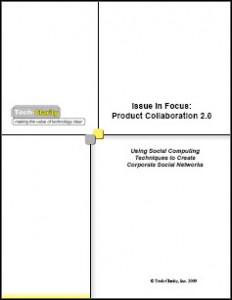A quick peek into some research on … the use of social computing and “Web 2.0” techniques to enhance product collaboration. The report, Issue in Focus: Product Collaboration 2.0 – Using Social Computing Techniques to Create Corporate Social Networks not only discusses how social media and Internet-based technologies can improve product collaboration in corporate social networks, but also how manufacturers’ use of social computing allows them to capture and leverage the interactions as a new source of corporate product knowledge.
One of the key messages of the report is that companies are starting to embrace social computing and “Web 2.0” capabilities to take advantage of social media for business purposes, creating “corporate social networks.” It is important for many companies to make a clear distinction between personal use of social media (Facebook, Twitter, MySpace, YouTube, etc.) and “real work” using social computing. While many large companies have shut down access to social media sites, these same concepts offer the ability for engineers, product developers, marketers, manufacturing resources, sourcing, and others in the product innovation process to share and contribute.
There are two primary threads to the research:
- Improving Collaboration – As reported in my previous post and research Going Social with Product Development, capabilities like presence detection and interactive file sharing help make existing collaborative processes better. This is particularly important to replace the day-to-day “water cooler” conversations that have disappeared in today’s globally dispersed, virtual organizations and support processes such as concurrent engineering. For example, manufacturers can create a virtual “community space” to give team members a central location for information. This collaboration extends beyond Engineering as well, and helps product developers include downstream considerations from Manufacturing, Purchasing, Quality, Service, and other departments early in the design process.
- Capturing Product Knowledge – Another key finding of the research is that as manufacturers adopt social computing in PLM, they are developing a digital record of the product development process. Decisions, discussions, false starts, brainstorms, and other interactions can now be captured and stored electronically. Using PLM, they can also be associated to the product and the project to form a permanent record of the process. By integrating this social interaction with search capabilities in PLM (see Unlock My Product Data! Business Intelligence in PLM), the potential to turn collaboration into a corporate asset is tremendous. Beyond capturing internal knowledge, corporate social networks can also be used to collaborate with suppliers and customers to gain better insights into the “voice of the customer,” capture requirements, and generate new product ideas – developing new knowledge and intellectual property (IP).
Implications for Manufacturers
There are significant business benefits to be unlocked by applying social computing techniques to product development. Manufacturers have an opportunity to improve collaboration inside and outside of the enterprise by leveraging these new techniques. After all, social computing is about sharing content within a community. Isn’t that what collaboration is all about? Sharing and getting feedback? And while the thought of using Facebook or Twitter to share your intellectual property may not sound that appealing (as we discussed in Flogging the Facebook for Product Development Horse), the same concepts are being applied to (and integrated with) PLM. I believe that these capabilities will be a big part of product innovation moving forward, and that companies that get started sooner will have a big advantage over their peers. This is a new and exciting frontier, and we all need to explore and learn so we can tap the new potential ahead of the competition.
So that was a quick peek into some recent research on social computing and collaboration, I hope you found it interesting. Does the research reflect your experiences? Do you see it differently? What are your plans? Let us know what it looks like from your perspective.
And as always, please feel free to review more free research and white papers about PLM and other enterprise software for manufacturers from Tech-Clarity.

